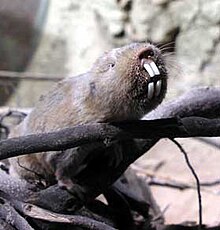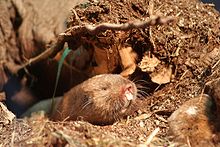Gray owl
| Gray owl | ||||||||||||
|---|---|---|---|---|---|---|---|---|---|---|---|---|

Ansells Graumull ( Fukomys anselli ) |
||||||||||||
| Systematics | ||||||||||||
|
||||||||||||
| Scientific name | ||||||||||||
| Fukomys | ||||||||||||
| Kock et al., 2006 |
The gray mole ( Fukomys ) are a genus of the sand burrows (Bathyergidae) within the rodents (Rodentia), which are mainly adapted to the underground and burrowing way of life. Currently, ten to fourteen different species have been described, depending on the source, and new species are still being discovered with improved research methods.
features
Representatives of the gray mull reach a body length of nine to 27 centimeters. The jaws and the associated masticatory muscles , which are very strong, are particularly adapted to the underground way of life . The incisors are very long and their roots can reach behind the molars in the jaw . They are used as digging tools, with the lower incisor teeth moving independently of each other.
Body appendages such as the tail and the outer ears are regressed, as are the eyes. Despite the reduced auricles, the animals can perceive vibrations and sounds very well. All species have short, dense fur, which can vary in color from yellowish to various gray and brown tones to reddish brown and usually has a velvety shimmer. In addition, the gray bull is unable to drink due to its protruding teeth. He uses the water from the food.
Morphologically and morphometrically , the two genera Fukomys and Cryptomys cannot be clearly separated due to their parallel development and intraspecific variability; the differences lie primarily in the area of molecular biological characteristics. The genus Fukomys is characterized and diagnosed accordingly only on the basis of features of the allozyme and on the basis of markers of the mitochondrial and nuclear DNA ( nuclear DNA ). In addition, there is a very variable number of chromosomes in the genome , which ranges from 2n = 40 to 2n = 78 and contrasts with the stable number of 2n = 54 in Cryptomys .
distribution and habitat
Fukomys live only in Africa south of the Sahara . They prefer steppes and savannahs as well as dry forests. The distribution area extends from Ghana and Nigeria in West Africa to South Sudan and from the southern Democratic Republic of the Congo and southern Tanzania to the Western Cape and Limpopo in South Africa .
Way of life

The gray mole live in self-dug tunnel systems, which they dig with the help of their powerful incisor teeth. They feed almost exclusively on a vegetarian basis from underground tubers; Small animals such as earthworms , beetle larvae and the like are rarely eaten. Activity on the surface of the earth is very rare, but occurs when the animals seek nesting material or seeds and leaves for food.
All gray mullet species live in colonies of a maximum of 40 animals. The colony size and the formation of the social structures are very different depending on the species. The largest colonies are the Damara gray mole rat ( F. damarensis ), which, like the naked mole rat ( Heterocephalus glaber ), was found to be eusocial in the colony. This is characterized by the fact that only one or at least very few animals in the colony are capable of reproduction, while the other animals share the work tasks - the social structure is thus similar to that of state-building insects with a queen. The sex animals produce very high levels of sex hormones in the gray mulls, while the development of the gonads in the working animals is reduced.
The dimensions and depth of the tunnel systems depend on the nature of the soil; in the case of looser soils, they are usually deeper. The large living room and several storage rooms are located relatively high in the ground, from which corridors radiate in all directions. The main digging activity of the gray mulls is during the times when the soil is more humid, when they create corridors to new sources of food. Gray mulls orient themselves in their extensive cave system to the magnetic field of the earth.
As part of an ecological study, the tunnel systems of 16 colonies of Ansell's gray mole, resident in Zambia, were measured. According to the findings, an average of 9.7 animals lived in a colony, the tunnel system per colony extended over 6919 square meters on average and had a length of 1241 meters.
Reproduction and development
The sex animals of the gray mole can have offspring all year round, with up to three litters per year in extreme cases. A litter consists of two to three young animals that are born after a gestation period of around three months. The animals are nestled , the eyes open after about 24 days. F. damarensis is weaned after about 82 days and the animals have reached their full size after about 210 days. The females are sexually mature after an average of 73 weeks when they become sex animals.
These development times can vary depending on the species, but the most extensive data are available for the Damara gray mole.
Systematics
|
Phylogenetic systematics of the sand graves
|
The systematics of the gray mull is unclear and they are accordingly considered differently in the literature. Traditionally, they were grouped together as the genus Cryptomys Gray , 1864, and some of them are still represented that way. On the basis of molecular biological analyzes, however, two clearly separated taxa were identified , whereupon a division into the genera Cryptomys and Coetomys was made. In the genus Cryptomys, only the African gray bull ( Cryptomys hottentotus ( Lesson 1826)) and the Cryptomys natalensis , Cryptomys nimrodi and Cryptomys anomalus and Cryptomys holosericeus, which are generally not considered to be independent species, remained . However, since Coetomys was not available as a name, as it was previously used as a synonym for Cryptomys , the new generic name Fukomys was proposed and implemented as an alternative in 2006 . Both genera together form the sister group of a taxon from the beach graves ( Bathyergus ) and the Cape Blessmull ( Georhychus capensis ).
The gray mullets of the genus Fukomys are currently counted around ten to fourteen species, depending on the doctrine. Some of these species have only been newly described or re-established in recent years, after they were previously assigned to the African gray mullet as subspecies or synonyms . The following species follow the description in the 2016 Handbook of the Mammals of the World , which distinguishes 14 species:
- Zambian gray mullet ( Fukomys amatus Wroughton , 1907)
- Ansells Graumull ( Fukomys anselli Burda , Zima , Scharff , Macholán & Kawalika , 1999)
- Bocages Graumull ( Fukomys bocagei De Winton , 1897)
- Damara gray mullet ( Fukomys damarensis Ogilby , 1838)
- Mashona gray mullet ( Fukomys darlingi Thomas , 1895)
- Nigerian gray gull or fox gray gull ( Fukomys foxi Thomas , 1911)
- Fukomys hanangensis Faulkes et al. 2017
- Kafue-Graumull ( Fukomys kafuensis Burda , Zima , Scharff , Macholán & Kawalika , 1999)
- Fukomys livingstoni Faulkes et al. 2017
- Giant gray mull ( Fukomys mechowi Peters , 1881)
- Central African gray mull ( Fukomys ochraceocinereus Heuglin , 1864)
- Katanga-Graumull ( Fukomys vandewoestijneae from Daele et al., 2013)
- Malawi gray mull ( Fukomys whytei ( Thomas , 1897))
- Ghana-Graumull or Zech-Graumull, Fukomys zechi ( Matschie , 1900)
Ingram et al. 2004 and Kock et al. In 2006 the list was supplemented by Fukomys whytei , Fukomys micklemi and two species that were undescribed at the time.
The generic name Fukomys is derived from the vernacular word stem “Fuko” for gray mullet or the verb “fuk (ul) a”, which in the Bantu languages stands for the excavation of the earth by mulle in the distribution area of the giant gray mullet . The ending "-mys" is often found in rodents and means "mice".
Gray bull and humans
Gray mulls feed on subterranean root tubers and also those grown by humans. As pests, they are hunted and eaten in some regions. Most species are common, and the species is only endangered if the range is very small (e.g. the Zechgraumull and the Nigerian gray bull).
supporting documents
- ↑ a b c d e f Dieter Kock, Colleen M. Ingram, Lawrence J. Frabotta, Rodney L. Honeycutt, Hynek Burda: On the nomenclature of Bathyergidae and Fukomys n. Gen. (Mammalia: Rodentia). Zootaxa 1142, 2006; Pp. 51-55.
- ↑ Jan Šklíba, Vladimír Mazoch, Hana Patzenhauerová, Ema Hrouzková, Matěj Lövy, Ondřej Kott, Radim Šumbera: A maze-lover's dream: Burrow architecture, natural history and habitat characteristics of Ansell's mole-rat (Fukomys anselli). In: Journal of Mammals . Vol. 77, No. 6, November 2012, pp. 420-427, doi : 10.1016 / j.mambio.2012.06.004 .
- ↑ a b c d e Colleen M. Ingram, Hynek Burda, Rodney L. Honeycutt: Molecular phylogenetics and taxonomy of the African mole-rats, genus Cryptomys and the new genus Coetomys Gray, 1864. Molecular Phylogenetics and Evolution 31 (3), 2004; Pp. 997-1014. doi : 10.1016 / j.ympev.2003.11.004
- ↑ a b Nigel C. Bennett: Genus Cryptomys - Mole-rats In: Jonathan Kingdon, David Happold, Michael Hoffmann, Thomas Butynski, Meredith Happold and Jan Kalina (eds.): Mammals of Africa Volume III. Rodents, Hares and Rabbits. Bloomsbury, London 2013, pp. 648-649; ISBN 978-1-4081-2253-2 .
- ↑ a b R.L. Honeycutt: Genus Fukomys. In: Don E. Wilson, TE Lacher, Jr., Russell A. Mittermeier (editors): Handbook of the Mammals of the World: Lagomorphs and Rodents 1. (HMW, Volume 6), Lynx Edicions, Barcelona 2016; Pp. 368-370. ISBN 978-84-941892-3-4
- ↑ a b C.G. Faulkes et al. 2017. Relic populations of Fukomys mole-rats in Tanzania: description of two new species F. livingstoni sp. nov. and F. hanangensis sp. nov. PeerJ 5: e3214; doi: 10.7717 / peerj.3214
- ^ A b Paul AAG von Daele, Pieter Blondé, Robert Stjermstedt, Dominique Adriaens: A new species of African Mole-rat (Fukomys, Bathyergidae, Rodentia) from the Zaire-Zambezi Watershed. In: Zootaxa . Vol. 3636, No. 1, April 3, 2013, pp. 171-189, doi : 10.11646 / zootaxa.3636.1.7 .
literature
- Ronald M. Nowak: Walker's Mammals of the World. 2 volumes. 6th edition. Johns Hopkins University Press, Baltimore MD et al. 1999, ISBN 0-8018-5789-9 .
- Nigel C. Bennett: Genus Cryptomys - Mole-rats In: Jonathan Kingdon, David Happold, Michael Hoffmann, Thomas Butynski, Meredith Happold and Jan Kalina (eds.): Mammals of Africa Volume III. Rodents, Hares and Rabbits. Bloomsbury, London 2013, pp. 648–649 and the following species descriptions; ISBN 978-1-4081-2253-2 .
- RL Honeycutt: Family Bathyergidae (African Mole-Rats). In: Don E. Wilson, TE Lacher, Jr., Russell A. Mittermeier (editors): Handbook of the Mammals of the World: Lagomorphs and Rodents 1. (HMW, Volume 6), Lynx Edicions, Barcelona 2016; Pp. 352-370. ISBN 978-84-941892-3-4

